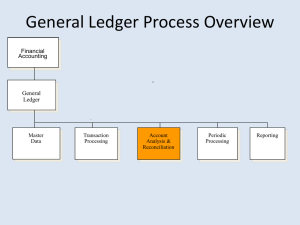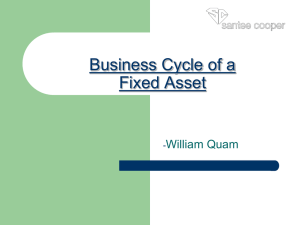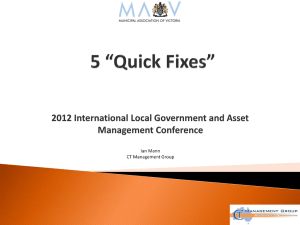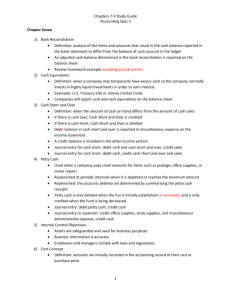Professor Paul Zarowin - NYU Stern School of Business
advertisement
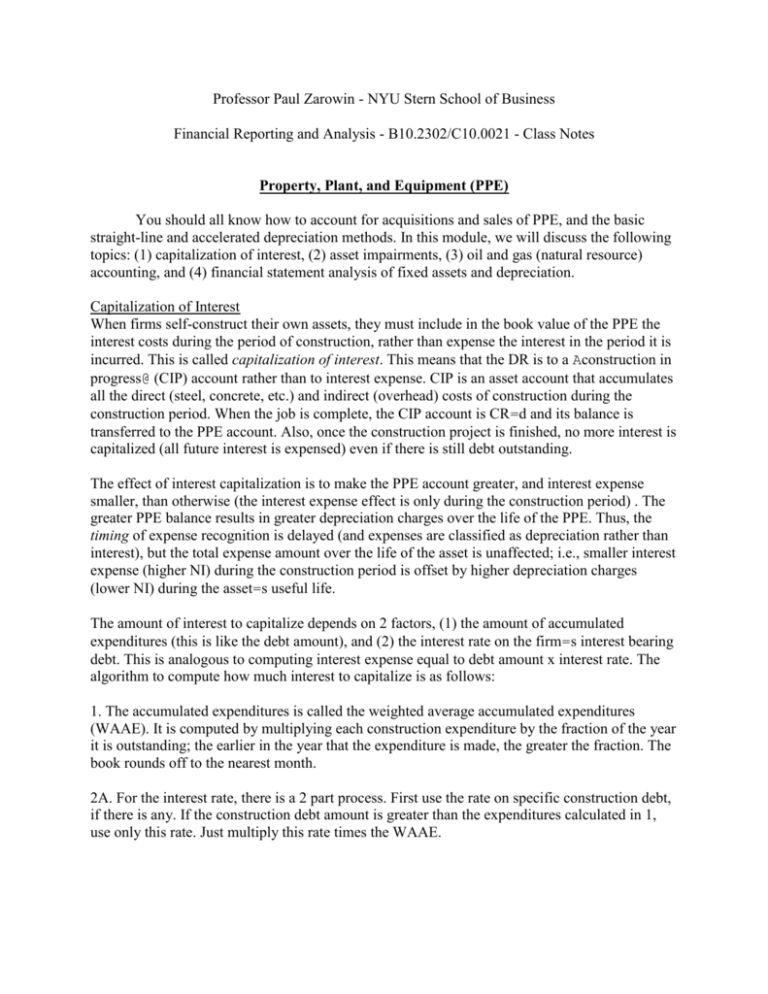
Professor Paul Zarowin - NYU Stern School of Business Financial Reporting and Analysis - B10.2302/C10.0021 - Class Notes Property, Plant, and Equipment (PPE) You should all know how to account for acquisitions and sales of PPE, and the basic straight-line and accelerated depreciation methods. In this module, we will discuss the following topics: (1) capitalization of interest, (2) asset impairments, (3) oil and gas (natural resource) accounting, and (4) financial statement analysis of fixed assets and depreciation. Capitalization of Interest When firms self-construct their own assets, they must include in the book value of the PPE the interest costs during the period of construction, rather than expense the interest in the period it is incurred. This is called capitalization of interest. This means that the DR is to a Aconstruction in progress@ (CIP) account rather than to interest expense. CIP is an asset account that accumulates all the direct (steel, concrete, etc.) and indirect (overhead) costs of construction during the construction period. When the job is complete, the CIP account is CR=d and its balance is transferred to the PPE account. Also, once the construction project is finished, no more interest is capitalized (all future interest is expensed) even if there is still debt outstanding. The effect of interest capitalization is to make the PPE account greater, and interest expense smaller, than otherwise (the interest expense effect is only during the construction period) . The greater PPE balance results in greater depreciation charges over the life of the PPE. Thus, the timing of expense recognition is delayed (and expenses are classified as depreciation rather than interest), but the total expense amount over the life of the asset is unaffected; i.e., smaller interest expense (higher NI) during the construction period is offset by higher depreciation charges (lower NI) during the asset=s useful life. The amount of interest to capitalize depends on 2 factors, (1) the amount of accumulated expenditures (this is like the debt amount), and (2) the interest rate on the firm=s interest bearing debt. This is analogous to computing interest expense equal to debt amount x interest rate. The algorithm to compute how much interest to capitalize is as follows: 1. The accumulated expenditures is called the weighted average accumulated expenditures (WAAE). It is computed by multiplying each construction expenditure by the fraction of the year it is outstanding; the earlier in the year that the expenditure is made, the greater the fraction. The book rounds off to the nearest month. 2A. For the interest rate, there is a 2 part process. First use the rate on specific construction debt, if there is any. If the construction debt amount is greater than the expenditures calculated in 1, use only this rate. Just multiply this rate times the WAAE. 2B. If the WAAE exceed the construction debt amount (or if there is no construction debt), calculate the weighted average interest rate on all other (non-specific construction) debt. Then multiply this rate by the excess (of the WAAE over the construction debt). Add the result from 2A with the result from 2B. The sum is called the avoidable interest. You capitalize the lesser of the avoidable interest and the actual interest expense (not cash paid). If the actual is greater, the excess is interest expense in the current period. Once the construction job is finished, all interest is expensed, even that on specific construction debt. It is important to understand that the avoidable interest is directly affected by the firm=s capital structure: a firm only capitalizes interest if it has interest bearing debt (including zero coupon debt), and a firm with little debt capitalizes less than a firm with lots of debt. All equity firms do not capitalize interest. Thus, how a firm finances its construction is a key, since only the costs of debt, not of equity, are included in self-constructed PPE: firms that finance their construction by issuing equity or by using internal funds do not capitalize interest. Interest capitalization results in higher NI and equally higher total asset and O/E amounts during construction. These effects on income (and therefore O/E) and assets impact rate of return and leverage ratios. Since ROA and ROE are generally 5%-25%, capitalization raises return ratios during construction (add one to both the numerator and denominator of a ratio less than one). Once construction is finished, the lower NI (due to the extradepreciation) and higher asset and O/E balances cause ROA and ROE to be lower than without interest capitalization. Higher assets and O/E result in lower leverage ratios. Asset Impairments An impairment is the decline in a asset=s value below its carrying value (net book value). Accounting records an impairment if the undiscounted future cash flows from the asset (including any cash expected to be received from its disposition) are less than the asset=s carrying value. If this condition is met, the loss on impairment equals the difference between the asset=s carrying value and its discounted future cash flows. Note the inconsistency here: you determine impairment based on undiscounted cash flows, but you calculate the loss based on discounted cash flows. The impairment journal entry is: DR CR Loss on impairment Accumulated depreciation Thus, the asset=s net book value is reduced by increasing its accumulated depreciation. Once you have taken the writedown, you cannot undo the impairment if the asset recovers any value, if you hold the asset for future use. If you intend to dispose of the asset, you can undo the impairment (of course, you cannot write the asset up above its original, pre-impairment, value). Oil and Gas (Natural Resource) Accounting The using up of natural resources is called depletion. It is analogous to depreciation for PPE and amortization for intangible assets. Depletion is usually done on a units of production basis (you should remember the units of production depreciation method from introductory accounting). The total estimated production from the well is called the recoverable reserves, and the % produced each period equals the amount produced that period divided by the estimated recoverable reserves. The periodic depletion expense equals that production% x the depletion base (cost of the well). The depletion base equals: acquisition costs + exploration costs + intangible development (drilling) costs + restoration costs. The key issue in oil and gas accounting is the choice of the full cost (FC) or the successful efforts (SE) method. The FC method capitalizes and depletes the above costs of all (including dry) holes. The SE method expenses the cost of the dry holes immediately, and only capitalizes the costs of the successful wells. This is an example of accounting=s capitalize vs expense choice. SE=s expensing (writing off) the dry holes is consistent with the definition of assets as having a future benefit; i.e., since dry holes have no future benefit, their costs should be expensed immediately, not capitalized. The FC method treats all the wells as a portfolio. Often the estimate of recoverable reserves (the denominator in the units of production calculation) changes. This is just a change in accounting estimate. As always, just go forward with the new estimate, and do not change anything retroactively. Since oil prices fluctuate a lot and since oil is traded in liquid markets, oil and gas firms must also report supplemental (footnote) data called reserve recognition accounting, which is based on the market values of the firm=s recoverable reserves. Note that the present value (based on the current market values) of a firm=s reserves is a ceiling above which the capitalized FC amount cannot go. Any costs above this ceiling must be expensed immediately. While the choice of SE vs. FC is a typical capitalize vs. expense accounting choice, the politics behind it has created much heat. RCJ=s discussion of the standard setting process is enlightening. As always, the capitalize vs expense choice has implications for the I/S, B/S, and ratios. SE shows larger expense during the drilling period (dry well expense) but lower depletion charges thereafter, relative to FC. FC always shows higher TA and O/E. Financial statement analysis of fixed assets and depreciation Many facets of long-lived asset reporting are important to the analyst. We discussed the effects of interest capitalization, and of SE vs. FC, above. The effect of different depreciation methods (how conservative vs. aggressive) and changes in methods or estimates are important to be aware of when comparing different firms at a point in time or a firm over time. Remember, conservative vs. aggressive accounting affects both the I/S and the B/S (ex. lower depreciation = higher NI higher total assets = higher O/E). Also, since asset book values and depreciation are based on historical costs (which are lower than current or replacement costs, and the difference increases with the asset=s age) the B/S and I/S figures depend on asset ages. This can distort profitability and leverage ratios, since the denominator is understated, and the effect is uneven across firms, depending on the average age of their assets. Likewise, different useful life and depreciation method choices can make cross-firm comparisons difficult. In addition to the I/S and B/S, information about fixed assets is found in the statement of cash flows: depreciation expense in the operations section, and capital expenditures (and asset retirements) in the investing section.

